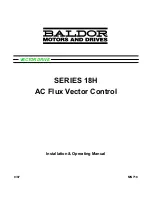
230
SIEPCYEUOQ2V01A Q2V Technical Manual
Code
Name
Causes
Possible Solutions
oFA12 to
oFA17
Option Card Connection Error
(CN5)
A fault occurred in the option card.
1.
De-energize the drive.
2.
Make sure that the option card is correctly connected to the
connector.
3.
If the problem continues, replace the option card.
Note:
Do a Fault Reset to clear the fault.
Code
Name
Causes
Possible Solutions
oFA30 to
oFA43
Communication Option Card
Connection Error (CN5)
A fault occurred in the option card.
1.
De-energize the drive.
2.
Make sure that the option card is correctly connected to the
connector.
3.
If the problem continues, replace the option card.
Note:
Do a Fault Reset to clear the fault.
Code
Name
Causes
Possible Solutions
oH
Heatsink Overheat
The ambient temperature is high and the heatsink
temperature of the drive is more than the value set
in
L8-02 [Overheat Alm Level]
.
•
Measure the ambient temperature.
•
Increase the airflow in the control panel.
•
Install a cooling device (cooling fan or air conditioner) to
lower the ambient temperature.
•
Remove objects near the drive that are producing too much
heat.
The load is too heavy.
•
Measure the output current.
•
Decrease the load.
•
Decrease the value set in
C6-02 [Carrier Frequency
Selection]
.
The internal cooling fan of the drive stopped.
1.
Use the procedures in this manual to replace the cooling fan.
2.
Set
o4-03 = 0 [Fan.Oper Setting = 0 h]
.
Note:
•
The drive detects this fault if the heatsink temperature of the drive is more than the value set in
L8-02
.
•
Do a Fault Reset to clear the fault.
•
If the drive detects this fault, it will operate the motor as specified by the Stopping Method set in
L8-03 [Overheat Pre-Alarm Selection]
.
Code
Name
Causes
Possible Solutions
oH1
Heatsink Overheat
The ambient temperature is high and the heatsink
temperature of the drive is more than the
oH1
detection level.
•
Measure the ambient temperature.
•
Increase the airflow in the control panel.
•
Install a cooling device (cooling fan or air conditioner) to
lower the ambient temperature.
•
Remove objects near the drive that are producing too much
heat.
The load is too heavy.
•
Measure the output current.
•
Decrease the load.
•
Decrease the value set in
C6-02 [Carrier Frequency
Selection]
.
Note:
•
The drive detects this fault if the heatsink temperature of the drive is more than the
oH1
detection level.
o2-04 [Drive KVA Selection]
determines the
oH1
detection level.
•
Do a Fault Reset to clear the fault.
•
L5-08 [U/OV,OH,GF A-Reset Select]
disables the Auto Restart function.
Code
Name
Causes
Possible Solutions
oH3
Motor Overheat (PTC Input)
The thermistor wiring that detects motor
temperature is defective.
Correct wiring errors.
A fault occurred on the machine.
Example: The machine is locked.
Examine the machine and remove the cause of the fault
The motor has overheated.
•
Check the load level, acceleration/deceleration time, and motor
start/stop frequency (cycle time).
•
Decrease the load.
•
Increase the values set in
C1-01 to C1-08 [Acceleration/
Deceleration Times]
.
•
Set
E2-01 [Mot Rated Current (FLA)]
correctly to the value
specified by the motor nameplate.
•
Make sure that the motor cooling system is operating correctly,
and repair or replace it if it is damaged.
•
Adjust
E1-04 to E1-10 [V/f Pattern Parameters]
. For motor 2,
adjust
E3-04 to E3-10
. Decrease the values set in
E1-08 [Mid
A Voltage]
and
E1-10 [Min Output Voltage]
.
Note:
If the values set in
E1-08
and
E1-10
are too low, the overload
tolerance will decrease at low speeds.
Note:
•
When
H3-02 or H3-10 = 16 [MFAI Function Select = Mot PTC Input]
, the drive detects this fault if the motor overheat signal input from analog input terminal AI1 or AI2 is
more than the alarm detection level.
•
Do a Fault Reset to clear the fault.
•
If the drive detects this fault, it will operate the motor as specified by the Stopping Method set in
L1-03 [Motor oH AL Reaction Select]
.
Summary of Contents for Q2V Series
Page 2: ...This Page Intentionally Blank 2 SIEPCYEUOQ2V01A Q2V Technical Manual...
Page 12: ...12 SIEPCYEUOQ2V01A Q2V Technical Manual...
Page 18: ...i 2 Legal Information 18 SIEPCYEUOQ2V01A Q2V Technical Manual...
Page 26: ...1 2 Features and Advantages of Control Methods 26 SIEPCYEUOQ2V01A Q2V Technical Manual...
Page 38: ...2 8 Installation Methods 38 SIEPCYEUOQ2V01A Q2V Technical Manual...
Page 70: ...3 3 Main Circuit Wiring 70 SIEPCYEUOQ2V01A Q2V Technical Manual Models B006 B012...
Page 102: ...3 17 Motor Application Precautions 102 SIEPCYEUOQ2V01A Q2V Technical Manual...
Page 138: ...4 12 Test Run Checklist 138 SIEPCYEUOQ2V01A Q2V Technical Manual...
Page 144: ...5 2 European Standards 144 SIEPCYEUOQ2V01A Q2V Technical Manual...
Page 145: ...Standards Compliance 5 5 2 European Standards SIEPCYEUOQ2V01A Q2V Technical Manual 145...
Page 146: ...5 2 European Standards 146 SIEPCYEUOQ2V01A Q2V Technical Manual...
Page 266: ...7 10 Troubleshooting Without Fault Display 266 SIEPCYEUOQ2V01A Q2V Technical Manual...
Page 284: ...8 6 Storage Guidelines 284 SIEPCYEUOQ2V01A Q2V Technical Manual...
Page 312: ...10 10 Peripheral Devices and Options 312 SIEPCYEUOQ2V01A Q2V Technical Manual...
Page 430: ...11 21 Parameters Changed by PM Motor Code Selection 430 SIEPCYEUOQ2V01A Q2V Technical Manual...
Page 731: ...SIEPCYEUOQ2V01A Q2V Technical Manual 731 Z Z pulse Auto Tuning 125...
















































